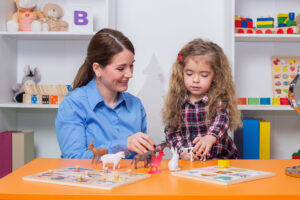
Seamless IEPS Focus On Students’ Goals, Not OT Goals
- Posted by Pediatric Therapeutic Services
- Categories Occupational Therapy
- Date May 4, 2019
Serve Students Best By Keeping School-based Ot Goals In Perspective
Eighteen years ago, I started my career in school-based Occupational Therapy (OT) believing my Certified Occupational Therapy Assistants (COTAs) and I could do anything.
We had the know-how. We had lots of great ideas. We had enthusiasm! We could break down any barriers between students and a free appropriate public education.
Unfortunately, we didn’t have magic wands!
Working with kids was the fun part. The not-so-fun part was the paperwork avalanche constantly threatening to bury us.
We dutifully provided a paper trail. We were determined to have enough evidence to show we were working hard with students to reach the OT goals on their Individualized Education Programs (IEPs). It was all necessary, I told myself. All part of the job.
But while my team and I wanted to share stories about our students’ progress on their journeys, harried teachers—stressed out and weighed down by their own burden of required forms—only wanted our input about those OT goals and objectives on the IEP.
Despite their positive outcomes during OT sessions, students weren’t replicating their stellar progress in the teachers’ classrooms. This disconnect between outcomes realized in OT and in the class setting became yet another obstacle to overcome.
I had to find a way to bridge this gap.
It didn’t matter how wonderfully the student worked for us in OT. If he or she couldn’t succeed in the classroom, OT would continue indefinitely. The marathon would turn into a race on a hamster wheel.
I had to get us off the wheel!
Putting Occupational Therapy Goals for Students in their Proper Place
Ultimately, the goals of an IEP are supposed to be about the student.
Occupational therapy goals for students, in elementary, middle, or high school, aren’t supposed to be about the OT itself. The same goes for any other therapy discipline: Physical Therapy (PT), Speech Language Pathology, or the rest.
But when parents and other advocates want goals specifically identified by discipline written into an IEP, what’s the unintended result? The focus tends to shift from where it properly belongs: the student.
This lack of focus leaves us with what I call a “Rubik’s Cube IEP”—a mixed-up jumble of different parts with distinct boundaries, a “this is mine and this is yours” approach instead of a seamless IEP supporting students’ ability to engage and learn.
In the school setting, all therapy, including OT, is supportive. Education is the primary service.
Keeping this priority clearly in mind, the COTAs and I collaborated with the rest of the IEP team to create student goals, not OT goals.
Initially, we were met with resistance. We had to break through a frustrating “we’ve always done it this way” mentality.
Federal regulations make clear “IDEA does NOT require goals to be written for each specific discipline or to have outcomes and measurements on a specific assessment tool.” You can find this provision on page 46662 of the Federal Register (Vol. 71, No. 156), which presents the U.S. Department of Education’s 2006 final rule on Assistance to States for Education of Children with Disabilities and Preschool Grants for Children with Disabilities.
But while the law doesn’t require separate discipline goals, it also doesn’t prohibit them. If the school team decides the OT will be solely responsible for a particular objective, that decision is what the team will write into an IEP.
Changing that mindset was a tough uphill climb. But eventually, we made it! We showed the IEP team successful and relevant student outcomes where we supported the teacher, the student, and the IEP goals, all without creating distinct OT goals on the IEP.
Reframe the Conversation About OT Goals
We’ve learned to avoid stumbling blocks by defining our role as a related service provider. When teachers ask us, “What are your OT goals?,” we reframe the conversation by identifying student goals on the IEP we’ll help the student achieve.
So, for example, we don’t talk about OT goals for sensory processing. We talk about how we’ll contribute to students achieving the goal of increasingly staying focused and “on task” in class by equipping them with weighted pens or fidgets and training them in brief “warm-up” activities like stretches or jumping jacks.
Another case in point: occupational therapy goals for students with Down syndrome. We don’t regard OT goals as “treatments” for the condition, as though we have a toolbox full of “solutions to a problem.” Students are not problems; students face problems accessing and engaging with their education. Instead, then, we intervene to help them learn to print their name, cut with scissors, or use a keyboard—all fine motor skills needed to meet the goal of increased classroom participation and success.
Again, shifting the focus back to where it belongs—not the OT goals themselves, but the goals of the student with Down syndrome—clarifies school-based therapy’s purpose for teachers and parents, and nurtures students’ academic and social progress.
One more example: When we’re asked, “What are some appropriate occupational therapy goals for high school students?”, we answer, “It depends on what the student wants to accomplish.” The American Occupational Therapy Association recommends different OT interventions for teens living with autism, for instance, based on the ultimate goal, whether it’s increased participation in social activities with peers or growing as a more independent problem-solver.
The Bottom Line: Stay Focused on the Student
OT can support the goals written into IEPs in certain ways; other therapy disciplines can support them in other ways. But the goal, not the discipline, remains front and center.
Our goals as OTs—or as any other type of school-based therapist, for that matter—are and must always be students’ goals. We are going to cross the finish line together with the student, as a team.
Thanks to Liz for reminding us of how important it is for IEP goals to be the child’s goals, not discipline-specific goals! If you’d like to find out how you can join the PTS team as an occupational therapist, click here to contact us.
You may also like

Occupational Therapy Appreciation Month


